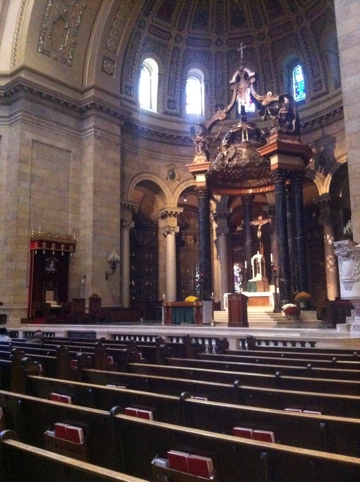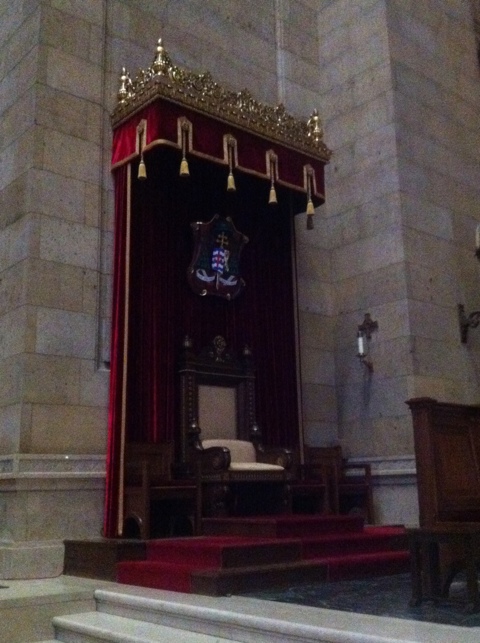The destruction inflicted on our churches in the name of Vatican II still makes the angels weep.
However, a restoration is slowly picking up momentum.
Here is a good example.
I like to visit the Cathedral if my native place, St Paul and Minneapolis. It is now also the National Shrine of Saint Paul. A grand building.
Today I noticed something new, which is something old, restored.
See it over there on the Gospel side wall of the sanctuary?
Let us have a closer look.
The rector found the baldichin for the Archbishop’s cathedra and had it reinstalled.
There is a suitable cloth of honor and the archiepiscopal coat-of-arms.
I am delighted by this, especially because the Archbishop here is leading an effort in defense of marriage.
Minnesota is likely going to be ground zero for defense of marriage, it seems to me, and the bishops will be in the thick of it. Archbp. Nienstedt seems determined. He seems to have nailed his colors to the mast in the run up to the vote on the amendment in defense of marriage. Therefore, I take the restoration of the baldichin to be a small but important symbol that he means business.
Refreshing!
WDTPRS kudos to the Rector Fr. Johnson and Archbp. Nienstedt.





































Yay!!!
Additionally, with the two stools for the Assistant Priests and the steps providing room for the other Sacred Ministers, the cathedra is ready for a Pontifical High Mass in the Extraordinary Form of the Roman Rite. In Christ,
Ooooh ya!
I don’t know about angels weeping over all churches where this occured. Most in America were cheap paste imitations of earlier styles. That said, I would love to know what the H happened to the great baldachino which used to be in the Greensburg, Pa. cathedral.
“The destruction inflicted on our churches in the name of Vatican II still makes the angels weep.”
And probably nowhere worse than in Europe… Centuries-old ten-foot high carved, gilded altarpieces thrown to the fire, to be replaced with white-washed walls… Precious marble, gilded altars and rails adorned with ivory intricacies, containing the relics of local saints martyred for their witness to the Faith, smashed with sledgehammers, so the Unbloody Sacrifice can be celebrated on a table of vibrated concrete, with a poor excuse for a candle if we’re lucky…
Like someone said to me once: “At least we know now what the Reformation felt like.”
Glad to see we’re on the way back on track!
The Cathedral in St. Paul is truly one of the treasures of North America. A breathtaking church, and one of my favorite things to visit when I’m in the Cities. I’m glad that these restorations were made. Fantastic.
Refreshing indeed!
Absolutely beautiful, and it is wonderful to see these returns to the way things should be. To unchange the changes… …I wonder how many churches that removed communion rails and pulpits, etc have kept them stored away, just waiting for a return!
Great! Now to remove that altar table and start using the real altar located underneath the big baldacchino.
Rood-screen by rood-screen, chancel by chancel, tramezzo per tramezzo.
Often overlooked is the fury of architectural dessecration that went on in the wake of Trent by way of litrugical dissenters, under the guise that the people need to see what is going on. Instead of minimizing the screens too often they were entirely removed leaving nothing in the sky to correspond with the altar rail on the ground. It is only logical that altar rails were to be removed next, and then high-altars, and then the steps, etc.
Methinks I ranted.
Now, if only the interior “renovation” of beautiful St. Charles Church in Toluca Lake can be halted. The death of Dolores Hope futher clears the way.
This is retired Cardinal Mahoney’s home parish. He resides nearby. The ruination of the interior of this lovely church is, thereby, almost assured. Parishoners have been fought to a standstill. Our new Archbishop Gomez would be our last hope, but how does he cross swords with his predecessor, even if so disposed?
So many people lost and so much richness lost over these past few decades.
Angels are weeping over the necessity of defense of marriage probably, too. I hope Minnesota’s people stand up the way easterners did not. Saint Paul would be a great help today.
Father,
I love it when I see a throne with a baldachin but: –
a) Doesn’t the Novus Ordo Caeremoniale Episcoporum directs that the throne of a bishop should be without a baldachin?
b) On the other hand, what does the EF Caeremoniale say about this? Is the baldachin mandatory over a bishop’s throne? If so, then, given the EF’s restoration, don’t we have a conflict of norms between the two forms of the legally one Roman Rite, thus allowing for an option in favour of the restoration of the baldachin?
I LOVE the title.
I’ve been intrigued with a question about the Baldacchino that I have not been able to find. All I can find is the “solomonic columns” in St. Peters.
I had heard that the baldachin had old testament connections. It’s not just the baldachin, but the use of the ombrellino and the canopy when the Blessed Sacrament is in procession.
Is there not a connection between the Blessed Sacrament always having some kind of covering over the top, and what we read about the Ark of the Covenant, which also had to be covered?
If anyone knows where I can confirm or negate this, please drop a comment here, or email me: TeDeumBlog (at) gmail (dot) com.
Happily, this restoration of so many ‘desecrated Churches’ to their original splendor continues, both here in Europe and throughout the US. I am only so very sorry that my old friend and mentor Monsignor Schuler (at the Church of St. Agnes in St. Paul, Minnesota from 1956 until his death in 2007) is still not here with us to see this restoration taking place. He brought great inspiration and hope (as well as such beautiful music) to so many; a blessing from which we all could greatly benefit during these incredibly troubled times.
We like the sword in the Coat of Arms.
Hooray!
Stand your ground, Your Excellency, against those who would ‘redefine marriage’!
Prof Basto brings up a good point. The question of a baldichin over the cathedra recently came up here in our archdiocese and the CE ( CoBs) was deferred to on the issue. I would be very interested to see some other opinions (based on the facts, please) on the matter such as as presented by the always interesting Prof Basto
I thought New York was ground zero for defense of marriage. I hope Archbishop Nienstedt and the bishops in his Arcdiocese do a better job in Minnesota than was done in New York. Actually, this a battle that may well come down to the next election since the Obama administration absolutely refuses to enforce the Defense of Marriage law. Pax.
Diane at Te Deum Laudamus
“Like so many other aspects of ecclesiastical design, the baldacchino is layered with symbolic and associative content. Its meanings are illuminated by considering its historical origins and the stream of images that link it with other theological, biblical and liturgical ideas.
The altar canopy is evidently derived in part from a secular practice in the ancient courts of Asia and the Eastern Roman Empire. Monarchs and other high personages presented themselves on their thrones under fabric canopies. Apart from whatever shelter from the elements it may have provided, the canopy was a sign of honor, representing the majesty of the royal person, and also made him or her clearly distinguishable and easy to see in a crowd. A lightweight framework and fabric hangings allowed the canopy to be portable. This practice entered the Roman world in the late Empire and, following the collapse of Roman civilization, was revived again in the Carolingian period. A painting of the Holy Roman Emperor Otto III in the year 1000 depicts him enthroned below a canopy supported by columns and hung with fabrics.
Similar canopies were erected over the thrones of bishops, and many cathedrals feature elaborate baldacchinos over the bishop’s throne, a practice no longer permitted in new construction. The baldacchino was also found in the papal conclaves. Before Paul VI discontinued the practice, the Cardinals assembled in the Sistine Chapel sat under fabric canopies color-coded for the pontificate in which each had been elected. After the new Pope was selected and pronounced his new name, the other Cardinals collapsed their canopies as a sign that authority had now passed from the College of Cardinals to the new Pontiff. A fascinating photograph from around 1950 shows a papal procession with Pius XII carried in his sedan chair under a billowing portable canopy supported on poles carried by his attendants.”
from http://www.sacredarchitecture.org/articles/introibo_ad_altare_dei/
Earlier in the article, the author states that these were mandated after the “reformation” in Ceremoniale Episcoporum, to emphasize the Real Presence, I would surmise.
@Prof Basto
If something is meet and just before a change that something is grandfathered, as is the custom in law. Unwritten custom trumps writ in nearly every cicumstance.
Just this week, our Cathedral in Wichita has been closed for a year of renovations. Wichita’s Cathedral was designed by the same architect as St. Paul’s, although it is a smaller version. In the 70’s, it was “simplified,” which meant painting over much of the imagery and decorative elements. The old baldachino over our Bishop’s chair is rumored to have ended up over a king-sized bed in a wealthy area of town, and two large marble angels flanking the altar still stand in a Catholic cemetery. Although the renovations this time around include some questionable things (a more “table-like” altar for example), much visual imagery will be added back in, along with richer colors and a sanctuary arrangement more like the original design. We pray that our artistic and theological heritage is returned in our Cathedral, along with a roof that doesn’t leak!
Now that’s a cathedra. It’s always very heartening to me to see this sort of restoration of things lost. When our Cathedral was renovated about a decade ago, it was the satisfying opposite of the ‘wreckovation’ that it replaced. Away went the ghastly semi-circular sanctuary, cheaply carpeted in unimagintive red; away went the modern, stylized “gothic” furniture and altar; away went all the crappy art. In came the traditional sanctuary and altar, marble and gilt everywhere. And back came the old cathedra from it’s “hiding” place in the Chancery. No canopy, however.
I was just today at adoration at a local suburban parish, one that my sainted grandmother belonged to. The original building, by no means worthy of retaining, was replaced by a larger church in the 1970s. The architecture can be described as disappointing. Nevertheless, the previous pastor of the church managed to make the place beautiful in its own way. He constructed an adoration chapel that’s just lovely and which overlooks the main church, now filled with beautiful icons and statuary, and a magnificent crucifix suspended above the altar.
More and more I see our treasures being returned to us in a way I never expected to see, and I smile whenever I see one more “old” thing that was taken out of storage and returned to use, or whenever I see traditional elements pop-up in more modern churches, as if to spite the architecture.